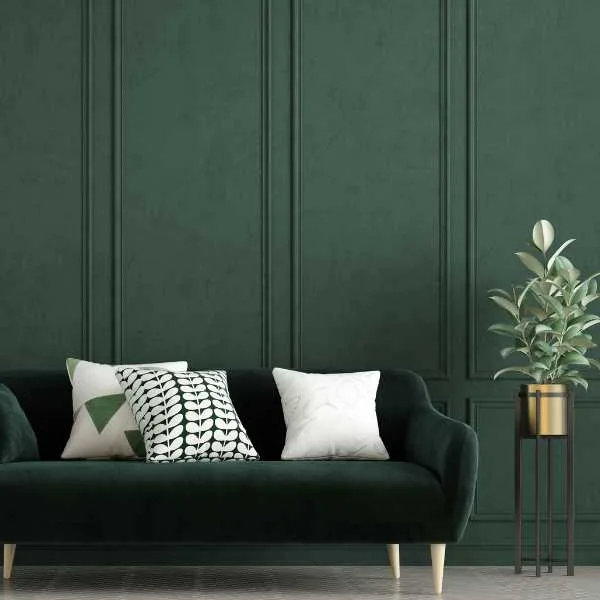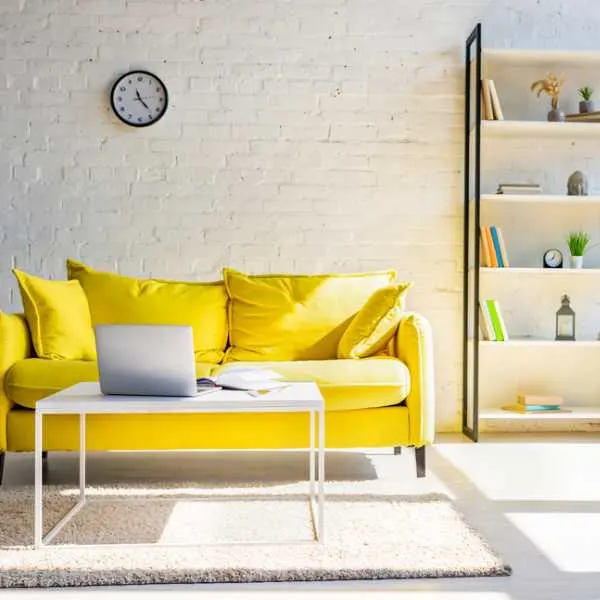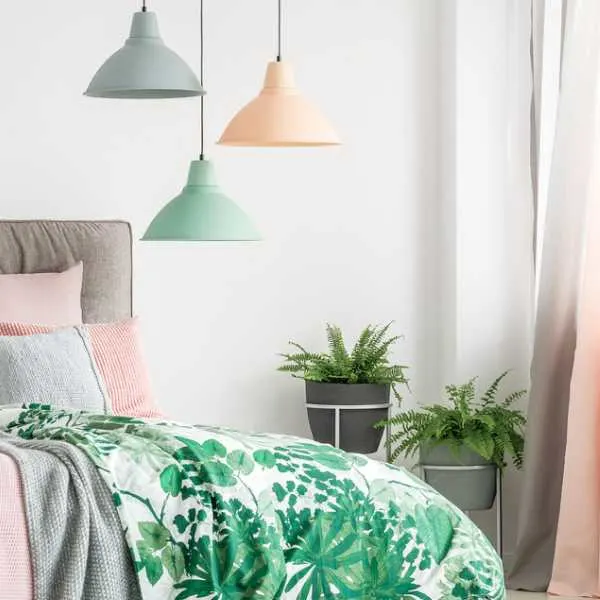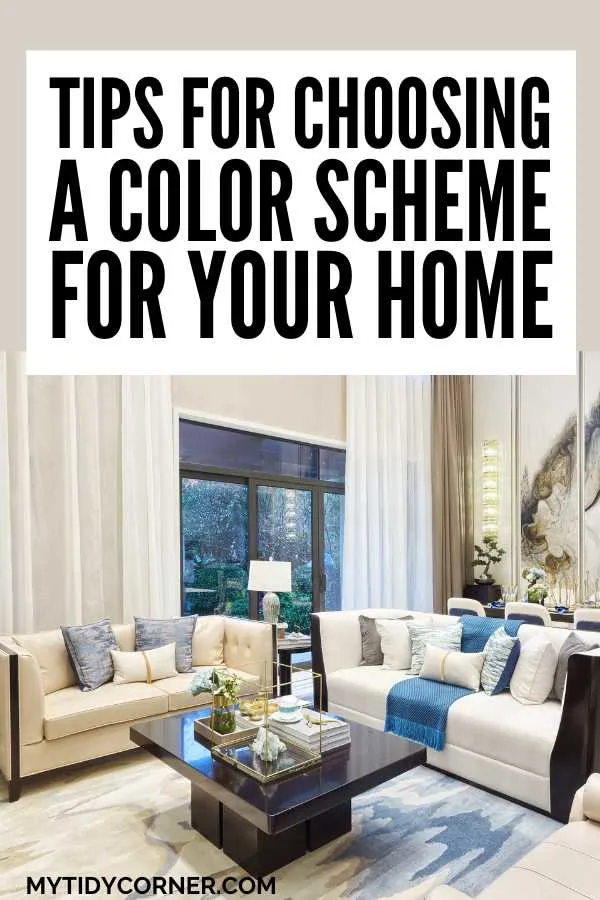Learn how to choose a color scheme for your home with this comprehensive guide. Picking the right color scheme will help you create balance and harmony in your home interior.
I get a kick out of exploring the shops each new season, looking at what’s fresh and what old trends have been updated. (Remember when brown was the new black?)
While we don’t update our homes’ color schemes quite so often, moving or renovating gives you the chance to experiment and refresh the palette.
Choosing a color scheme for your home isn’t as easy as buying a sweater in a daring new shade. But it’s not as hard as you may think. So let’s look at how to select your home’s color scheme.
To choose a color scheme for your home, determine your personal color preferences and lifestyle-appropriate colors. Map out each room, noting light and existing furnishings. Use the color wheel to choose three to four colors as the basis for a color scheme, which you can carry throughout your home.

7 Simple Tips for Choosing a Color Scheme for Your Home
When faced with interior decorating, many of us choose the safe option of a neutral color scheme.
Unfortunately, this choice can lead to a dull environment. And you will miss out on the benefits of color, like energy and personality, brought to your home.
Here are some decorator-approved guidelines for choosing a color scheme for your home.
#1. Explore Your Lifestyle and Personal Style

Choosing a color palette can get confusing when there are so many gorgeous interiors on Instagram.
However, our homes should reflect the people who live there and meet our unique needs rather than slavishly following fashion.
Begin by considering your and your family’s style and lifestyle:
- What are your favorite colors? Look in your closet to give you a clue as to which colors you’re drawn to. Do you love green? Or stick to black?
- Are these practical colors for your lifestyle? (My sister had a very bad experience with a white linen sofa and three puppy dogs.)
- What aesthetic do you love? My sister is a huge fan of the eclectic, while her husband is a minimalist. They compromise on a Scandi Boho look.
- What atmosphere do you want to create? A family house should have a comfortable, welcoming vibe, for example.
- Do you have the budget to transform your whole house, or do you want to go room by room?
Spend time researching on Pinterest or Instagram, in magazines, collecting samples in paint shops or fabric shops, or creating a mood board.
#2. Map Your Home
Create a basic floor plan—there is even free software for this. You can then consider how rooms flow into one another and the relationship between different spaces.
- Are you planning a color scheme to thread through your whole house? This option creates a cohesive and harmonious impression.
- Are parts of the house open plan? Do the rooms flow into one another?
- Which architectural features will you want to highlight? For instance, you may have beautiful wooden floors, an unusual fireplace, or pressed steel ceilings.
- Which furniture items and fixtures remain in the rooms after the refresh or renovation? Do you have built-in cupboards and carpets that won’t be replaced? I don’t think I’ve ever started decorating a home that’s a complete blank slate—we all carry sentimental items
#3. Track the Light

While mapping your home, notice how the light in each room changes throughout the day. Remember that color is created by reflected light, so the amount of light will impact your color choices, especially your choice of wall paint.
Generally, decorators regard daylight and sunshine as the ideal light sources, as they have uniform intensity. You’ll immediately notice the impact of light in a white room, as white reflects the color around it. For example:
- Light-starved, chilly rooms benefit from a brighter color scheme and appear even colder and duller if painted in muted shades.
- East-facing rooms get beautiful morning light, while west-facing rooms are lit by the magic of twilight.
- Rooms used in the evening will be lit by artificial light, lamps, or ceiling fixtures, which may emit red or blue light and create shadows.
#4. Be Inspired by What You Already Have
Few of us can furnish an entire home from scratch, so you will likely already have furniture, rugs, artwork, and decor items you’ll reuse once you’ve redecorated.
Take inspiration from these as the basis of a color scheme. For example, choose a color from a piece of gorgeous fabric you bought in Bali and use the fabric to make cushion covers.
#5. Investigate the Color Wheel

The color wheel is handy for inspiration and determining which colors work well together, depending on the effect you want to create.
Color Families
Create a harmonious, cohesive color scheme by choosing colors that tone or belong to the same color family.
For example, you could choose all purple tones, with violet, mauve, and lavender in a monochromatic color scheme. Minimalist interiors tend to use monochrome color schemes.
Analogous Colors
Analagous color lie next to one another on the color wheel. For instance, blues and greens, give a relaxed, serene vibe, which is why they’re popular for the coastal aesthetic. They’re also ideal for bedrooms.
Complementary Colors
Colors that lie opposite one another on the color wheel are complementary and create a vibrant, energetic look.
For instance, adding yellow to your purple palette will give it more punch. Eclectic and retro interiors tend to use complementary colors.
Warm and Cool Colors
An effective color palette may include warm or cool colors or both. Warm colors, like red and orange, are welcoming and inviting. In contrast, cool colors, like blue or green create tranquility. Neutrals like gray and white can also be warm or cool, depending on their undertone.
Combine both warm and cool tones to spark off each other.
Light and Dark Colors
Color value refers to how light or dark a hue is. Harmonious color schemes include both elements, usually with darker colors lower down to anchor the scheme.
#6. Choose Three Colors (Color Palette)

A completely monochrome color scheme will either be uninspired (all beige) or overwhelming (all yellow). Instead, designers follow a “magic” ratio:
| Color | Ratio | Function |
| Anchor or foundation color | 60% | Walls |
| Secondary color | 40% | Upholstery |
| Tertiary color | 10% | Decor |
Here are examples of color palettes using three colors in the magic ratio.
Neutral Color Scheme
Neutrals are appropriate for any aesthetic and work best when layered in patterns and textures. When used effectively, a neutral scheme is cozy and welcoming.
In a neutral color scheme, you could choose cream as the foundation color, beige as the secondary color, and pale green as the tertiary color. This combination ensures a balance between serenity and interest.
Cool Color Scheme
A cool palette includes greens or blues. However, the foundation color need not be either color—you can anchor the scheme with white, then add dark green and a lighter green. Add warmth with glowing wood and rich textures.
Warm Color Scheme
For a warmer color palette, you can start with a rich cream, then add earthy red and terracotta. Choosing a neutral anchor color allows the warmer shades to pop and displays your furniture and accessories to their full advantage.
#7. Weave a Golden Thread

Once you have chosen three colors, you can use them throughout the house, switching anchor colors in different rooms depending on the light. You can also enjoy tonal differences in different rooms, so long as you have a golden thread—touches of the colors—running throughout your home.
A color flow creates harmony, consistency, and a relaxed atmosphere, leading you from room to room, rather than a sudden surprise when a room in an otherwise neutral home is painted orange.
Your golden thread could be using the same trim color, type of wood, or artwork to carry through the color scheme.
Final Thoughts
Choosing a color scheme for your home need not be daunting if you start with colors you love and take inspiration from your existing furnishings. Choosing a palette based on three colors, neutral, warm, cool, or monochrome ensures balance and harmony, which you can carry through your home consistently.
Related Articles:
- A Guide to Decorating with the 60 30 10 Color Rule
- 8 Best Color Combinations for Navy Blue
- How to Make Your Home Look Cohesive
- 4 Simple Tips for Choosing a Home Decor Style

